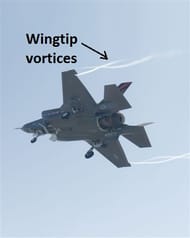Many of us would have wondered what those thin white streams are which come out of the rear endplates when the Formula One cars run down the straights, and which are specially seen when the conditions are damp.
These thin white streams are nothing but vortices of air produced when the rear wing generates downforce. The air moves at a higher velocity beneath the surface of the rear wing and at a lesser velocity above it. This generates lower pressure beneath the surface and hence a downward force is generated. As gases have a natural tendency to flow from high pressure to low pressure, the air tries to spill over the endplates, but cannot due to airspeed. Because of this spilling over effect, a spiralling effect is created. The high pressure air is directed along the top end of the endplates and rearwards outward from the car in the form of very high energy regions, called vortices. After travelling some distance behind the car, these vortices level out in the normal flow of air behind the car.
The basic difference between the wingtip vortices in Formula One cars and in aircrafts (as seen in the two figures) is that the vortices move upwards in case of an F1 car and downwards in case of an aircraft. This is simply due to the fact that an aircraft’s wing creates Lift and an F1 car’s wing creates Downforce – two exactly opposite things.
Now let us understand the thermodynamic reason behind the visibility of this interesting phenomenon. The basic assumption is that the whole process is an adiabatic process, with no heat exchange of the system with the atmosphere. So, according to the thermodynamic equation governing the adiabatic process, with an increase in pressure, temperature increases, and with a decrease in pressure, temperature decreases. The temperature we are talking about here is the temperature inside the vortex.
Another temperature which we need to understand is the Dew Point – the transition temperature from gas to liquid, corresponding to partial pressure of water vapour – which determines when we will see the vortices trail and when we won’t. The Dew Point decreases with decrease in pressure, and increases with increase in pressure.
After the formation of the vortex, the pressure inside it decreases significantly as compared to the ambient pressure. This results in a significant drop in dew point (which was already below the ambient temperature before the formation of the vortex) but along with it, there is an even greater drop in the vertex core temperature, which transforms the water vapour into water droplets and hence we are able to see the vortices trail coming out of the rear endplates.
This phenomenon is more prominent in damp conditions because the relative humidity of atmospheric air is high. As more relative humidity means an increase in partial pressure of water vapour, therefore there is a rise in the local dew point inside the vortex. As there is no change in total pressure and temperature, therefore the vertex core temperature now is easily below the dew point, and hence the water vapour condenses.
The vortices should not be confused with Contrails coming out of the exhausts of aircraft because of the presence of water vapour inside the exhausts. In case of Contrails, there is no significant drop in local temperature and pressure – it is more down to changes in relative humidity.


